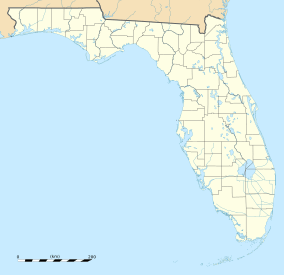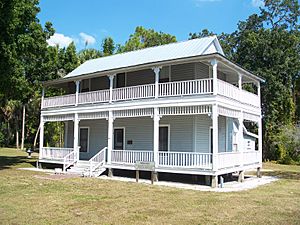Gamble Plantation Historic State Park facts for kids
Quick facts for kids Judah P. Benjamin Confederate Memorial at Gamble Plantation Historic State Park |
|
|---|---|
 |
|
| Location | Ellenton, Florida, USA |
| Governing body | Florida Department of Environmental Protection |
|
Robert Gamble House
|
|
| Built | 1845–1850 |
| Architectural style | Greek Revival Vernacular |
| NRHP reference No. | 70000189 |
| Added to NRHP | August 12, 1970 |
The Judah P. Benjamin Confederate Memorial at Gamble Plantation Historic State Park is a special place in Ellenton, Florida. People often call it the Gamble Mansion or Gamble Plantation. It's a Florida State Park where you can learn about history.
This park features a large, old mansion built before the American Civil War. Its first owner, Major Robert Gamble, developed it. The park also has a huge 40,000-gallon cistern that once held fresh water. It includes about 16 acres of what used to be a big sugarcane farm.
At its largest, the plantation covered 3,500 acres. Major Gamble used the forced labor of over 200 enslaved people to work the land and process the sugarcane.
The mansion is famous for its unique construction. Its columns and thick walls are made from a material called tabby. This material was a local way to build strong structures when bricks were hard to get. The mansion was added to the National Register of Historic Places in 1970.
The park also has the Patten House, a restored wooden house built in 1872.
In 1925, a group called the United Daughters of the Confederacy (UDC) bought the mansion and its land. They gave it to the state to honor Judah P. Benjamin. He was an important leader in the Confederate government during the Civil War. Benjamin stayed at the plantation in May 1865 while escaping from Union forces. He later sailed to England and started a new career there.
Today, the Gamble Mansion is home to the Florida Division UDC. In 1937, they placed a special plaque at the mansion to remember Benjamin. There is also a monument for Confederate Veterans, put up in 1937.
In 2002, Florida bought the land with the old sugar mill ruins. This mill was once one of the largest in the Southern United States. It is now part of the historic park.
In 2012, the AIA Florida Chapter named the Gamble Mansion one of Florida's top 100 architectural places.
Contents
Exploring the Plantation's Past
The area around the plantation has a long history. For thousands of years, different groups of Native Americans lived here. They left behind large shell mounds, showing they ate a lot of seafood. Tribes like the Tocobaga, Yamasee, Creek, Seminole, and Miccosukee lived in this region.
How the Plantation Began
After the Second Seminole War ended in 1842, the United States allowed people to settle in Florida. Major Robert Gamble Jr. came to the Manatee River area in 1844. He received 160 acres of land for farming. Other sugar planters soon joined him along the rich Manatee River.
These planters used the forced labor of many enslaved people. These workers cleared land, planted and harvested sugarcane, and built houses and mills. By 1845, many plantations along the river were sending their sugar to New Orleans.
Building the Gamble Mansion
The Gamble Mansion was mostly built by enslaved people, including skilled workers and laborers. They used local materials over five to six years. The mansion is a great example of the Greek Revival style.
The mansion's thick walls and columns are made of tabby. This special concrete was first used by Spanish and English settlers. It was an alternative to clay bricks, which were hard to make in the coastal soil. Enslaved African-American people helped create tabby. They mixed lime (from burned oyster shells), more crushed oyster shells, sand, and water. This mixture was poured into molds to harden, just like bricks. There were plenty of oyster shells from old Native Floridian villages.
Next to the house, you can see a large, covered cistern. It has a wooden roof and could hold 40,000 gallons of water. Major Gamble built it to provide fresh water for his household. Fish were even kept in the cistern to help keep the water clean!
Life at the Plantation
Major Gamble lived in the mansion and managed his large sugar plantation from there. By 1850, he owned 3,500 acres and enslaved 62 people. He also built many other buildings and slave quarters using tabby. A wharf was built to ship sugar and molasses by boat. At its busiest, over 200 enslaved people likely lived and worked on the plantation. However, due to money problems, Gamble sold the property in 1856. The Gamble Mansion is the only plantation house from that time still standing in peninsular Florida.
Judah P. Benjamin's Escape
During the American Civil War, Captain Archibald McNeill, a Confederate blockade runner, lived in the mansion. In May 1865, Judah P. Benjamin, who was the Confederate States Secretary of State, hid here. He was escaping from Union troops after the Confederacy lost the war. McNeill helped Benjamin escape to the Bahamas. From there, Benjamin sailed to England and became a successful lawyer.
The Sugar Mill and Patten House
The Gamble sugar mill was one of the largest before the Civil War. Union raiders destroyed it in 1864. You can still see the brick ruins about half a mile north of the mansion. Florida bought the mill property in 2002 and has made the ruins visible and protected them.
In 1895, Dudley Patten, a later owner's son, built the wooden, two-story Patten House for his family. This house is also part of the park. It has faced challenges with damage over the years. In 2018, it was chosen as one of "Florida's 11 to Save" by the Florida Trust for Historic Preservation. This program helps raise awareness about saving important historic places.
Saving the Mansion
Tabby is not as strong as brick over a long time. By 1902, the mansion was falling apart. In 1923, the Judah P. Benjamin Chapter of the United Daughters of the Confederacy (UDC) started raising money to save it. By 1925, they bought the house and 16 acres. They gave the property to the state to preserve it as a memorial to Judah Benjamin. The state finished restoring the house in 1927.
In 2010, a historian from the University of Florida led a study at the plantation. Students worked to document the plantation's history. Their goal was to help the plantation get an even higher historic designation.
Fun Activities at the Park
The park is open every day from 8 a.m. until sundown. You can take guided tours of the Gamble Mansion to learn more about its history. It's a great place to explore and imagine what life was like long ago.
Gallery
See also

















